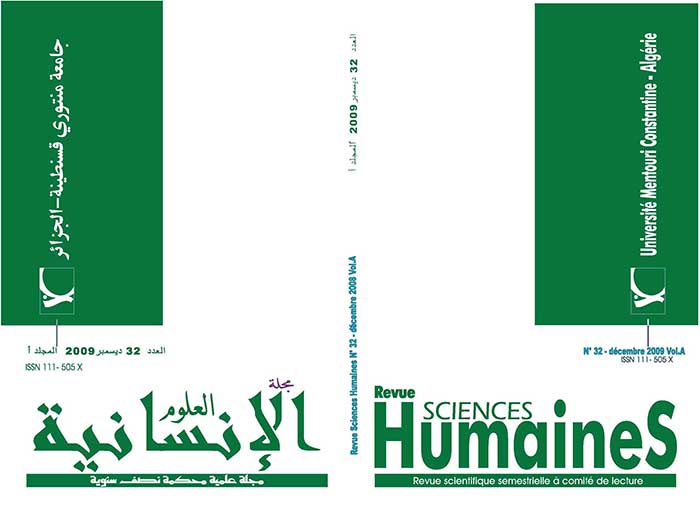Code-Switching and Borrowing in Algeria
الملخص
In Algeria, the coexistence of Arabic and French for a certain period of time has led to the emergence of language phenomena which may be found with varying degrees in many bilingual societies. Using an ethnographic approach, a sample of students at Mentouri University, Constantine, was recorded to identify and investigate mixing patterns. The paper first looks at the linguistic research on the structural features of code-switching focusing in particular on the code-switching versus borrowing distinction. Then, it analyses the different mixing patterns according to phonological and/or morphological integration. Finally, results reveal that although code-switching and borrowing are distinct phenomena, they may both be used within the same utterance.
التنزيلات
المراجع
-Backus, A. M. (1996). Two in one: Bilingual speech of Turkish immigrants in The Netherlands. Tilburg, The Netherlands: Tilburg University Press.
-BenabdI, L. C. (1980). “Arabization in Algeria: Processes and problems”. Ph.D dissertation, Indiana University.
-Bentahila, A., & Davies, E. D. (1983). “The syntax of Arabic-French code-switching”. Lingua, 59, 301-330.
-Collins, W. M. (2003). “Code-switching behaviour as a strategy for Maya-Mam linguistic revitalization”. OSUWPL, 57 (Summer), 1-39.
-Crystal, D. (1987). The Cambridge encyclopaedia of language. Cambridge: Cambridge University Press.
-Eastman, C. M. (1992). “Code-switching as an urban language contact phenomenon”. Journal of Multilingual and Multicultural Development, 13, 1-17.
-fishman, J. A. (1972). “Domains and the relationships between micro- and macro-sociolinguistics”, in J. J. Gumperz & D. Hymes (eds.), Directions in sociolinguistics: The ethnography of communication. New York: Holt, Rinehart, and Winston, 435-453.
-Gardner-Chloros, P. (1991). Language selection and switching in Strasbourg. Oxford: Oxford University Press.
-Grosjean, F. (1982). Life with two languages: An introduction to bilingualism. Cambridge, MA: Harvard University Press.
-Gumperz, J. J. (1982). Discourse strategies. Cambridge: Cambridge University Press.
-Gysels, M. (1992). “French in urban Lubumbashi Swahili: Code-switching, borrowing, or both”. Journal of Multilingual and Multicultural Development,13, 41-55.
-Haugen, E. (1956). Bilingualism in the Americas: A bibliography and research guide. Publications of the American Dialects Society 26.
-Heath, J. (1989). From code-switching to borrowing: Foreign and diglossic mixing in Moroccan Arabic. New York: Routledge, Chapman & Hall.
-Hudson, R. A. (1980). Sociolinguistics. New York: Cambridge University Press.
-Jacobson, R. (1990). “Foreword”, in R. JACOBSON (ed.), Code switching as a worldwide phenomenon. New York: Peter Lang.
-Kachru, B. B. (1983). “On mixing”, in B. KACHRU (ed.), The Indianization of English: The English language in India. New Delhi: Oxford University Press, 193-207.
-Milroy, L., & MUYSKEN, P. (1995). “Introduction: Code-switching and bilingualism research”, in L. MILROY & P. MUYSKEN (eds.), One speaker two languages: Cross-disciplinary perspectives on code-switching. New York: Cambridge University Press, 1-14.
-Myers-Scotton, C. (1993a). Duelling languages: Grammatical structure in code switching. New York: Oxford University Press.
-Myers-Scotton, C. (1993b). Social motivations for code-switching: Evidence from Africa. Oxford: Oxford University Press.
-Myers-Scotton, C. (1993c). “Common and uncommon ground: Social and structural factors in code switching”. Language in Society, 22, 475-503.
-Myers-Scotton, Carol. (1993d). “Comparing code-switching and borrowing”, in Carol M. Eastman (ed.), Code-switching. Multilingual Matters. Clevedon; Philadelphia, 19-39.
-Pfaff, C. (1979). “Constraints on language-mixing: Intrasentential code-switching and borrowing in Spanish/English”. Language, 55, 291-318.
-Poplack, S. (1978). “Dialect acquisition among Puerto Rican bilinguals”. Language in Society, 7, 89-103.
-Poplack, S. (1980). “Sometimes I’ll start a sentence in English y termino en español: Toward a typology of code-switching”. Linguistics, 18, 581-618.
-Poplack, S. (1981). “Syntactic structure and social function of code-switching”, in R. P. Durán (ed.) Latino language and communicative behavior. Norwood, NJ: Ablex, 169-184.
-Sridhar, S. N., & Sridhar, K. (1980). “The syntax and psycholinguistics of bilingual code-mixing”. Canadian Journal of Psychology, 34, 407-416.
- Weinreich, U., Labov, W., & Herzog, M. (1968). “Empirical foundations for a theory of language change”, in W. Lehmann (ed.), Directions in historical linguistics. Austin: University of Texas Press, 97-195.












